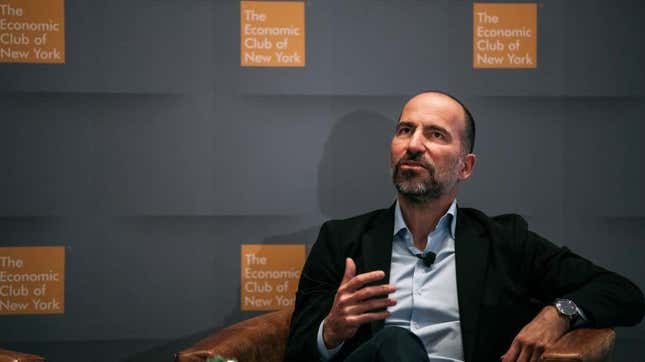
Uber is still doing everything in its power to fight the implication of California’s new independent contractor law, likely working its developers into the ground to roll out product features designed not to improve driver or rider experience, but to create flimsy legal defenses against an increasingly indefensible business model. You’d think there’d be an easier way.
For those not following the incremental drip of labor-circle news around this particular law, dubbed AB5, which I assume is most people, the legislation sets in place a stricter standard for determining whether a contractor is truly free of control from the firm, company, or platform that pays them. Despite what you may have heard, it neither immediately outlaws contracting, nor does it automatically enroll workers into a union. To some degree, the backward nature of labor laws in this country and the number of carve-outs in AB5 make these sorts of mischaracterizations inevitable; on the other hand, Uber and other “gig economy” firms seem intent to spread, or at the very least fail to correct, confusion that benefits them. And they’re doing it while suing California over the law on the charge that it’s “irrational and unconstitutional.”
Keep in mind, AB5 is merely an incremental escalation of what was already the letter of the law, as per a California Supreme Court ruling made nearly two years ago.
Muddying things further, Uber has made it a high priority to add features to its app only for users in California specifically to undermine the case that the company is in any way controlling the course of work for its drivers. In Uber’s view, it’s a platform for connecting drivers with passengers, not a taxi company, if you can believe that.
So, what’s the latest piece of misdirection? As the Wall Street Journal reported today, a small subset of drivers performing a small subset of rides in three small cities in California will get an obtuse bidding system for fares, which, one assumes, is meant to show that drivers are able to set their own prices—an important element of true contract work.
Uber’s latest changes will set up a bidding system that lets drivers increase fares in 10% increments, up to a maximum of five times Uber’s set price [...] Uber will match the rider with the driver who has set the lowest price [...] Starting next week, Uber plans to let drivers also set fares lower than Uber’s price. In addition to choosing a higher multiple, drivers will be able to charge as little as one-tenth Uber’s set price, decreasing fares 10% at a time. They will also be allowed to opt out of surge pricing.
So let’s examine this a bit:
Uber will [1] still set the base price, as well as [2] the minimum and maximum fare, [3] will decide who gets more rides based on how little they’re willing to work for, and will apply this system to [4] only trips originating at airports in Santa Barbara, Palm Springs, or Sacramento. Sorry, I’m not convinced this does anything to prove the relative independence of Uber’s contingent workforce!
The trajectory of venture capital-infused tech in the past decade or so has largely followed a simple formula of using superior resources to subsidize the product in order to capture market share—only to jack the price up once a critical mass of rubes (consumers, that is) have decided the service, widget, or gizmo is indispensable. Remember how much cheaper Uber rides used to be? That’s only possible when monied weirdos sink $25 billion into a dumb idea like reinventing the taxi. Increasingly, Uber has pushed costs onto its own drivers. Forcing them to bid one another down to unlivable wages is simply the latest in a long arc of declining driver wages.
So yes, in part this app feature is legal ammo for a case that is sure to drag on for absolutely-goddamn-ever. On the other, it’s something Uber can likely point to when confronted by its own drivers: ‘This is what your wages look like because of AB5—wouldn’t you like to go back to how things were?’ It’s another potential prong in the long con to get gig workers to fight against their own best interest, which until now has consisted mostly of conflating full-employee status with a lack of freedom, a false binary only Uber and its ilk are in the position to instate.
And while Uber and its corporate allies in opposing California’s AB5 contractor law are the clear villains of this particular narrative, I have plenty of empathy for the employees who, according to the Washington Post, devoted three to six (likely grueling) months to building out these and other features. Features—this fare-auctioning system, the ability to “favorite” riders—only serve to give Uber’s lawyers slightly more than fuck-all to work with when challenging a law designed almost expressly to address companies getting rich through exploitation of a contractor system.
According to one estimate, if Uber were to treat its drivers as employees it would cost them in the ballpark of $500 million, annually. With all the work Uber has piled onto its developers to get out of this jam (at whatever salaries those people pull), with all the confusion it’s putting drivers through (who are now more likely to predominantly use a competitor rideshare app), and all the money this deeply unprofitable company has or intends to blow fighting AB5 (in ballot measures, astroturf campaigns, legal fees etc.), you have to wonder: Did they ever think making the drivers into employees might just be easier?
Do you work at Uber? Are you a driver in Santa Barbara, Palm Springs or Sacramento? We’d love to talk to you. Reach out via email, Twitter DM, Keybase, or Secure Drop with your tips.